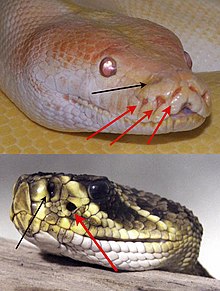Pit organ and labial pits
The pit organ and the labial pits are sensory organs that various snakes use to detect infrared radiation . During the evolution some have taxa of snakes particularly well to the detection of warm-blooded mammals specialized. This sense enables the snakes to hunt even in complete darkness.
The pit organ
The pit organ of the snake lies on the left and right of the anterior upper jaw between the nostrils and eyes in a depression in which there is a thin membrane . It acts as an antenna for infrared radiation (infrared receptor) and is well supplied with blood. Behind this membrane is an air-filled chamber.
The membrane is connected to numerous sensory nerve fibers of the trigeminal nerve , through which signals from the pit organ (through "thermal radiation") are transmitted to the roof of the midbrain ( tectum mesencephali ) and processed there. The infrared receptors on the membrane are part of the TRP family of receptors. These receptors are ion channels and are widely used as thermal receptors in the vertebrate nervous system . Pit organ snakes' TRP receptors are the most sensitive of all ion channels in vertebrates to temperature fluctuations.
With the pit organ, temperature changes from 0.003 K on the membrane can be detected.
For a subfamily of vipers , the pit vipers , the pit organ is eponymous. The pit-shaped arrangement of the receptors enables pit vipers to see a very precise spatial infrared image . In addition, the pit otters have the ability to link this infrared image with the visual image. This helps these otters to get a very precise, three-dimensional image even at night. The pit organ is on each side of the head between the eye and the mouth.
The labial pits



The labial pits have a floor with a strong blood supply (fundus) on which the infrared receptors are located. With these pits, the snakes can register temperature differences down to 0.026 K.
In the group of giant snakes , the species of the python family (except members of the genus Aspidites ) and also some genera from the boas family , such as the genus Corallus , have these pits. The pits are arranged in a more or less long row along the upper and lower lip. Each pit is sunk into a scale of the upper or lower lip (labial scale). The labial pits are evolutionarily independent (convergent) to the pit organs of the pit vipers and are not quite as effective as these.
literature
- AB Sichert, P. Friedel, JL van Hemmen: Snake's Perspective on Heat: Reconstruction of Input Using an Imperfect Detection System. Phys. Rev. Lett. 97 (2006), p. 068105 (1–4), preprint (available February 7, 2009; PDF; 260 kB)
Individual evidence
- ↑ EO Gracheva, NT Ingolia, YM Kelly, JF Cordero-Morales, G. Hollopeter, AT Chesler, EE Sánchez, JC Perez, JS Weissman, D. Julius: Molecular basis of infrared detection by snakes. In: Nature. Volume 464, Number 7291, April 2010, pp. 1006-1011, ISSN 1476-4687 . doi : 10.1038 / nature08943 . PMID 20228791 . PMC 2855400 (free full text).
